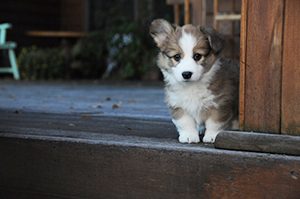Reader Question:
My 10 week old puppy seemed to do well the first several days we had him but it’s been a week and he’s still having accidents in the house. What can we do to fix this?
Answer:
While young puppies provide many precious moments they, like infants and toddlers, require an extraordinary amount of time, planning, and energy—usually much more than one predicts. One of the most trying tasks associated with having a puppy is potty training. Some people think that potty training is as easy as just keeping the pup on a regular eating, drinking and potty-outing schedule where he is taken out every several hours. Or they think that the pup will be completely house-trained in just a week or two. For some precocial pups (meaning offspring born relatively mature and independent) this might be so. Most pups taken through such a lax, abbreviated potty protocol remain only partially house-trained. They learn that outside is a good place to go but don’t understand that inside is off-bounds. In fact, they may even come inside after an extensive play or exercise period and then relieve themselves on your expensive carpet.
The Full Potty Training Protocol for Young Pups
Here’s what’s really required for foolproof potty training—it’s not an easy task. When the pup wakes up, let him out of his pooch-palace, a travel kennel just big enough for him to sleep in but not large enough for a bed plus bathroom. Immediately carry or run him out on leash to the preferred potty spot outside and stand there, stationary and silent until he’s done both #1 and #2. As he’s about to potty you can say the cue word “potty” just once so he comes to associate the word with the action. Then you can reward him as he’s finishing. But, otherwise, you’re silent so you don’t distract him from doing his duty. If he’s done both, then, he can come in and have a meal and play session. If he has not, then he goes back into his pooch palace for 15 minutes after which time you try again. Repeat this process until he’s done both #1 and #2 or he’ll potty inside as soon as you’ve taken a break and strayed from the plan.
Next, once he’s earned a free-time session you can let him loose in a small area if you can keep your eyes glued to him. As soon as you take your eyes off him, he’s sure to have an accident just as sure as your pasta water will boil over as soon as your attention is diverted elsewhere. Watch for signs (like sniffing the ground) that he’s ready to go potty again and run him outside if you’re unsure. Next, 15–20 minutes after he’s eaten or drank water, and every time he wakes up from resting or has been playing and slows down, take him out to go potty and reward him when he does. If he doesn’t potty, put him back in his crate for 15 minutes and then try again. During the rest of the day he should spend bouts sleeping in his crate, and you can regularly go through the same potty process you went through first thing in the morning. You may need to go through the process 4–6 times a day.
Once he’s relieved himself outside during the day, he can have a play session or be attached to you on leash so you’re more likely to catch the signs he wants to potty. The goal is that every time he goes outside, he sees this as his opportunity to potty and does #1 or #2, and when he’s inside he does not have an opportunity to make a mistake. This is the quickest way for him to develop an outdoor potty habit and to learn that indoors is not a normal potty place.
Usually after a week, you get a pup who goes potty outside on cue but who may still have accidents inside. This rigid routine must be carried out consistently for several months and without accidents for several weeks before it’s set. Even the most diligent owners should expect accidents and avoid getting upset. Just startle the pup if you catch him in the act so that you can hopefully get him to stop and then rush him outside to finish. Beware that if you punish him or cause him to be scared, he may just learn to potty in the house out of your sight so just chalk accidents up to your mistake and resume following the plan.
If this potty training process sounds like a drag, you’re right. The only thing more inconvenient than following this plan is having to randomly clean up after your dog in the house for the dog’s entire life.
Potty Training Refresher in a New House
What? You thought your dog was potty trained until he had an accident at your friend’s house? Well, he may be perfect in your house, but in new locations he may need to be retrained for a day or two. Even adult dogs frequently need to be retrained somewhat in every new home they visit so they understand where the new bathrooms are.




